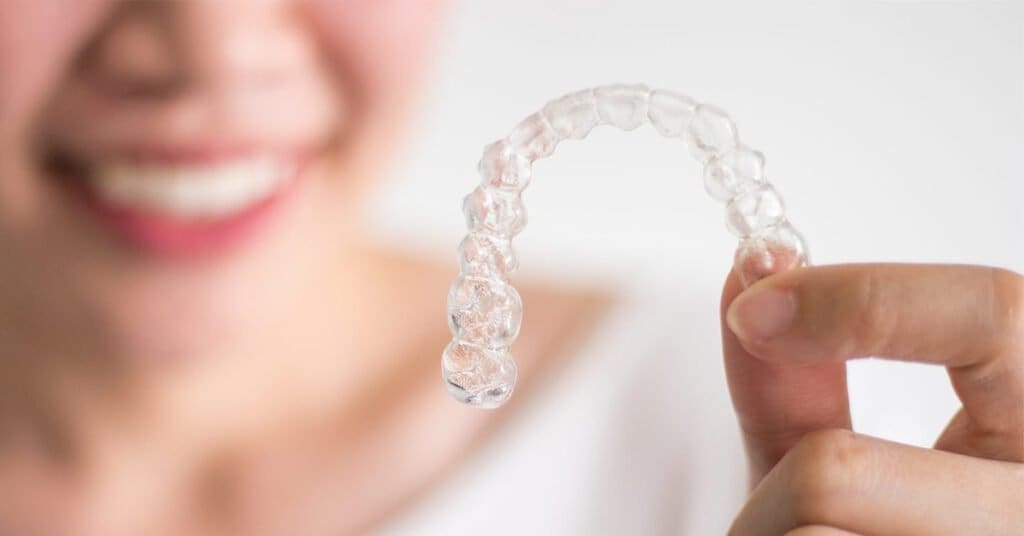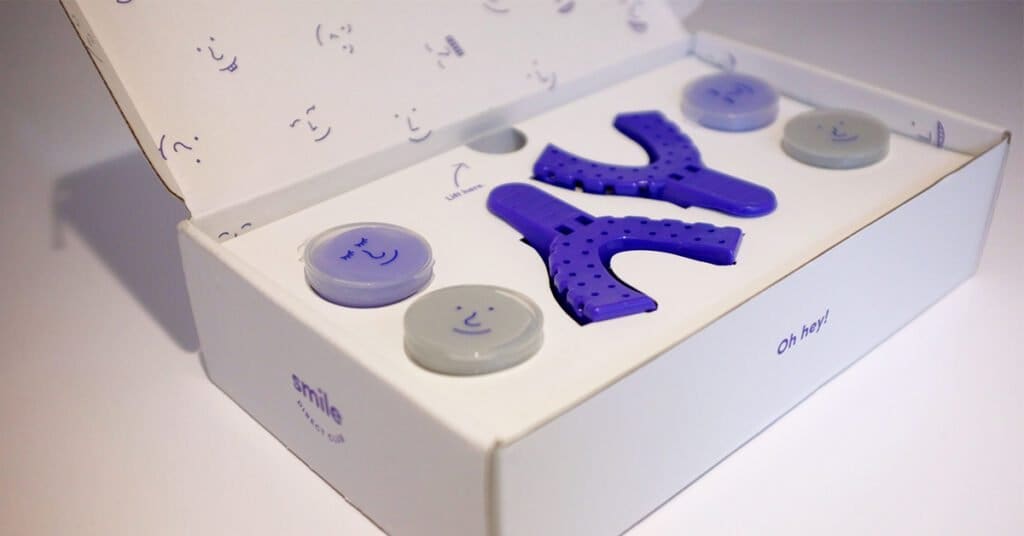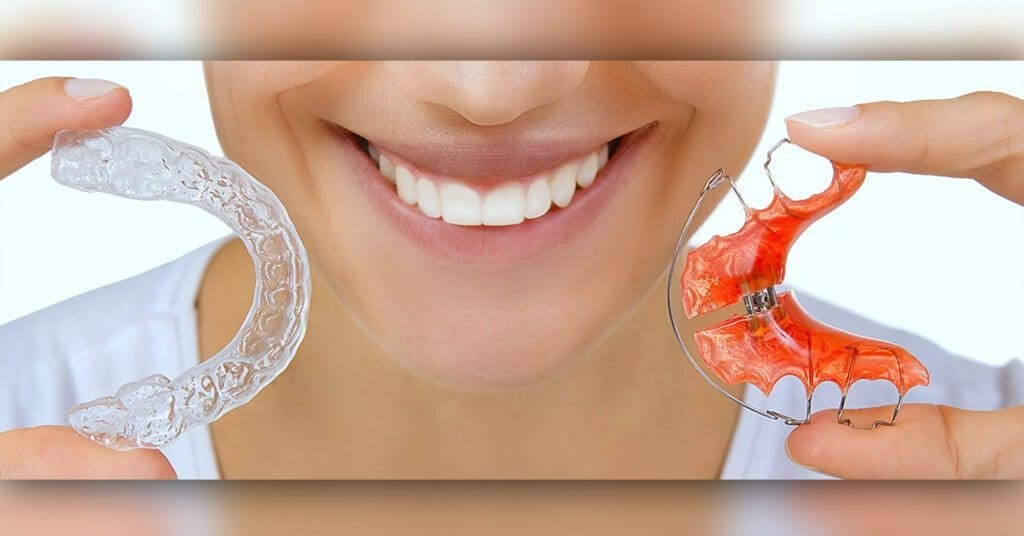Last year on June 16, Chinese orthodontic braces company, AngelAlign Technology, was officially listed on the Hong Kong Stock Exchange. It soared 131% at the opening, and the highest intraday increase was more than 180%.
It closed at HK$400.02 (US$51.18) in the afternoon. According to the IPO price of 173 yuan, it means that each winning lottery will earn a profit of 45,000 Hong Kong dollars; the big winner of this IPO and the controlling shareholder of AngelAlign, Songbai Capital, also successfully entered the circle.
Angelalign vs Invisalign
Known as the Chinese version of Invisalign, AngelAlign focuses on invisible orthodontic solutions. The market value of the Invisalign’s parent company Align Technology has reached US$47.5 billion, and its stock price has risen 30 times in 10 years.

In the age of beauty economy, advertisements such as “Torture is like plastic surgery” and “The upper half of the face determines the upper limit of beauty, and the lower half of the face determines the lower limit of ugliness” appear repeatedly, provoking young people’s desire for correction.
However, orthodontics is a non-medical insurance item, and many potential consumers are discouraged by high costs. Depending on the complexity of the case, the full correction cost of an AngelAlign treatment costs between US$2600 to US$6500. For comparison, an Invisalign treatment costs between US$4,600 to $9,400.
Big difference between cost and retail pricing
In fact, the production cost and ex-factory price of invisible braces (aligners) are not high. In the first 9 months of 2020, AngelAlign has corrected a total of 101,700 cases. The revenue of the invisible correction solution business line is 589 million yuan and the cost is 167 million yuan.
Based on those numbers, the average ex-factory price of each correction case is 5,832 yuan and the cost is about 1,642 yuan. Interest rates are close to 72%.
From costing US$770 – US$930 at the factory, to US$4,600 – $US$6200 in hospitals, clinics and other terminals, the price disparity has been seized on by some suppliers.
DTC (Direct To Customer) players of invisible orthodontics try to bypass hospitals or dental clinics and sell orthodontic solutions and braces directly to consumers through the Internet.
Companies in China are copying the SDC (Smile Direct Club) model, made popular in the United States – following a similar smile formula and slogan of “putting an end to any middlemen to make the difference”.
So, can invisible orthodontic services and products bypass middlemen and reduce prices? How much does orthodontics depend on doctors? The big data of brand manufacturer cases is rapidly accumulating. Is it possible to replace doctors with AI solutions?
Will direct-to-consumer sales model dominate the market?
Invisible orthodontics are in urgent need of price reduction. Does that make direct sales by brand owners a viable business model?
Consumers who check the Chinese product aggregator site, Pinduoduo, in search of orthodontic devices can easily locate a pair of orthodontic appliances retailing at US$1.50 to US$1.70 – boasting a healthy sales volume to boot.

Invisible braces, as a second-class medical device, are subject to strict approval by the Food and Drug Administration for their listing and production, and a doctor’s prescription is also required for use.
However, many people have the need for orthodontic treatment and lack medical knowledge. Enticed by low pricing and mass appeal publicity, they are easily lured.
According to the survey of the Orthodontics Professional Committee of the Chinese Stomatological Association, the overall prevalence of malocclusion in China was 67.82% in 2000, which means: For every 10 Chinese citizen, 7 have uneven teeth.
This data is not sensational, and it is true that misalignment of teeth, overbite (crossbite), buck teeth (deep overbite of front teeth), and crooked face (abnormal mandibular deviation) are common.
In the case of increasing consumption power, from 2015 to 2019, China’s orthodontic market maintained a compound growth rate of 20.7%, and invisible orthodontics started from scratch and quickly broke through the scale of 10 billion.
However, among the Chinese orthodontic population, the rate of using invisible braces is only 10.5%, and it has reached 33.1% in the United States.
An important reason for the low penetration rate is the high costs.
Why are clear braces so expensive?
Guoyuan Securities, CICC and other securities companies have listed “the uncertain market penetration rate” and “the unpredictable nature of promotion of invisible orthodontic products in the Chinese market” as risk warnings. So, what are the reasons for the high price of invisible orthodontics?
From the perspective of the circulation link, the sales of invisible braces from the manufacturer to the hospital/dental clinic will generate a sales fee; and additional fees levied when the product moves from the hospital/dental clinic to the consumer. In addition to the cost of customer acquisition, the operating cost of the hospital/clinic also be factored into the price package of invisible orthodontics.
Based on market calculations, the ex-factory price of invisible braces of Invisible Beauty and AngelAlign is 3-4 times the cost price, and the gross profit rate is about 70%.
However, in addition to production costs, sales expenses and R&D investment are also major expenses. In 2018 and 2019, the sales expenses of AngelAlign were approximately US$ 12,320,000 – US$18,480,000, accounting for 16.8% and 19% of the total revenue.

After amortization, the ex-factory price of each aligner case included about 1,000 yuan of sales expenses.
Similar to other medical devices, the sales expenses of invisible braces are mainly used for academic promotion, doctor training expenses, etc. The doctor’s prescription/recommendation directly affects the patient’s decision-making, so the ability to obtain a doctor is very important.
AngelAlign mainly focuses on direct sales, supplemented by distribution. The bulk of direct sales are aimed at dental clinics and private hospitals, contributing more than 60% of the income; distribution is an agency model for the public hospital system.
Admission to hospitals through provincial and municipal bidding has accounted for the proportion of distribution in the past three years, from 11% to 32.8%.
At present, in the same regional market, the price of invisible orthodontics in public and private dental institutions is basically the same, and the price in public hospitals is slightly higher. Private dental institutions often face fierce competition. In order to acquire customers, they need to advertise on various platforms.
Marketing costs growing with market size
An unnamed industry pundit estimates the cost of acquiring customers in the dental market is lower than that of medical beauty, but it is still very expensive.
The average customer acquisition cost of the three major items of orthodontics, implantation, and aesthetic restoration is about US$100 – US$310; and only a third of the customers attracted by the high price can actually be sold. The remaining two-thirds are often lost directly.
With the increasing number of dental clinics, the cost of launching various traffic platforms has also risen. In the past, a search engine platform could achieve a production ratio of 20/1. Now whoever can achieve 5/1 is divinely gifted, says another anonymous source.
In addition to customer acquisition costs, the costs of clinics/hospitals, rent, utilities, fixed assets, etc. are ultimately included in invisible orthodontic costs. What happens if brands bypass dental clinics and sell orthodontic solutions and invisible braces directly to consumers?
SmileDirectClub was established in the United States in 2014. They adopted the model of “remote consultation + invisible orthodontics” to reduce the price of invisible orthodontics to $1,950, which is only 25%-30% of the price of Invisalign. With low prices, SDC quickly broke the monopoly of Invisalign. In 2019, the number of correction cases in that year reached 453,000.
The clear brace market is unlike any other
Compared with metal bracket correction, dental implants, whitening restoration and other projects, why is it that only invisible orthodontics can achieve remote diagnosis and treatment in dentistry?
The answer can be summed up in one word: Invisalign.
After Invisalign was founded in Silicon Valley, it invented correction through oral scanners, 3D printing technology, and invisible braces, which greatly lowered the threshold for orthodontic technology.
Invisible orthodontic brands use big data and medical designers to formulate orthodontic plan recommendations, such as the precise angle of movement, which greatly complicates the process.
“For example, the overall movement of the 13th tooth has reached 3.8 mm, which is displayed in blue; the limit of tooth movement does not exceed 3mm, so this plan is obviously not feasible,” says Yang Maolin, president of Jiamei Dental Hospital (Beijing Poly Store). In the end, the orthodontic plan is determined by the doctor’s approval, including the need for tooth extraction, slice cutting, etc.
After the doctor decides the plan, manufacturers such as Invisalign and AngelAlign will make the invisible braces in different stages. Small protrusions are embedded in the braces and force is applied through the deformation of the material. The patient will visit the doctor regularly for follow-up consultation and adjustment.
Throughout the whole process, the doctor’s operation is far less complicated than the metal bracket correction. Invisible braces are customized and produced by the manufacturer, allowing consumers to easily wear and remove.

SmileDirectClub’s modus operandi
The SDS process is even simpler. In data collection, consumers have two options: take the mould with the tools mailed by SDC, or go to its outlet Smile shop for the oral scan. The doctor will then consult and review the correction remotely. After confirmation, SDC will mail the fabricated braces to consumers in stages. Throughout the treatment process, they will also conduct remote follow-up consultations with doctors.
After SDC went public, its stock price peaked, with a market value of more than $8 billion at one point.
However, there is an ongoing debate on the relationship between medical care and the Internet: Do technologies such as the Internet serve medical care, or it the other way around?
Many dentists would agree that the best treatment plan is still produced by orthodontists. No matter how large the database is, the results still need to be checked and scrutinized by doctors. Perhaps aware of the potential blowback, SDC is seeking cooperation with Heartland Dental (the US DSO organization).
Judging from the SDC annual report, its total revenue in 2020 is 657 million US dollars. There are about 250 orthodontists and general practitioners on the remote consultation platform. These 250 people provide invisible orthodontic services for 375,000 members, which means that on average, each physician provides correction services to 1,500 consumers a year.
Says Yang, metaphorically: “If orthodontics is regarded as “driving”, then the traditional use of metal brackets is like operating a manual gear.
“Orthodontics are technically difficult; but we have come a long way with automatic gears.”
“From the doctor’s point of view, we are more concerned about medical malpractice and risks.”
Invisalign and SDC: Clash of the titans
As a direct competitor, Align Technology, the parent company of Invisalign, obtained a 17% stake in SDC through patent litigation in 2016, and invested again in 2018 before its IPO. Invisalign once provided SDC with invisible braces as a third-party supplier, but the cooperation ended because Invisalign launched a model similar to SDC in stores, which violated the non-compete business agreement.
Before the advent of Invisalign, general dentists usually referred patients to orthodontists, but today’s general dentists perform 85%-90% of simple orthodontic cases.

The SDC model is also similar. With the rapid development of Internet platforms, from an industrial perspective, entrepreneurs are eager to transfer offline behaviour to online.
However, it is undeniable that the proportion of complex cases in the Chinese population is much higher than that in Europe and the United States, which means that a series of pre-treatments are required for orthodontics – such as fillings, scaling, and even root canals.
The Chinese dentist’s position
Many Chinese dentists believe that simple online remote orthodontics is unscientific, but a balance can be sought in medical care and business. For example, the first consultation and basic treatment are completed offline, and the frequency of offline follow-up visits can be reduced, supplemented by regular online follow-up.
The importance of orthodontists in the process of diagnosis and treatment may be self-evident, but whether it is SDC, Invisalign, or AngelAlign, big data, artificial intelligence and the digital revolution in dentistry are major factors mentioned in their respective financial reports/prospectus.
At present, there are only about 5000-6000 orthodontic practitioners in China. High-level orthodontists are quickly poached by institutions.
Will AI produce the next Invisalign?
Whether the experience and knowledge of orthodontists can be replaced by artificial intelligence is way too early to tell. At the core of this question is still case data: whether those who have the data have computing power, and whether those who have the computing power have the data.
In the highly competitive oral market, the pricing of physical products will definitely decrease with marketing, because the number of doctors authorized by brand owners is increasing. With establishment of domestic factories in Wuxi, Ziyang and other places, production capacity is no longer a constraint.
In the orthodontic process, the most luxurious is still the high-quality service of professional doctors, which is both functional and aesthetic. Invisible orthodontics seems to have a long way to go from digital products to artificial intelligence products.
The $64 million dollar question is: Who will bring real technological innovation and become the next Invisalign?
Source: Interface News
The information and viewpoints presented in the above news piece or article do not necessarily reflect the official stance or policy of Dental Resource Asia or the DRA Journal. While we strive to ensure the accuracy of our content, Dental Resource Asia (DRA) or DRA Journal cannot guarantee the constant correctness, comprehensiveness, or timeliness of all the information contained within this website or journal.
Please be aware that all product details, product specifications, and data on this website or journal may be modified without prior notice in order to enhance reliability, functionality, design, or for other reasons.
The content contributed by our bloggers or authors represents their personal opinions and is not intended to defame or discredit any religion, ethnic group, club, organisation, company, individual, or any entity or individual.

